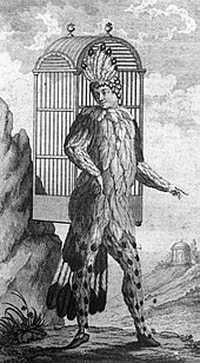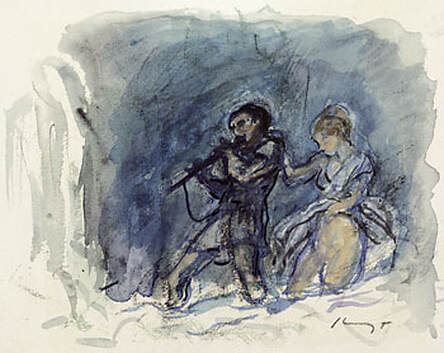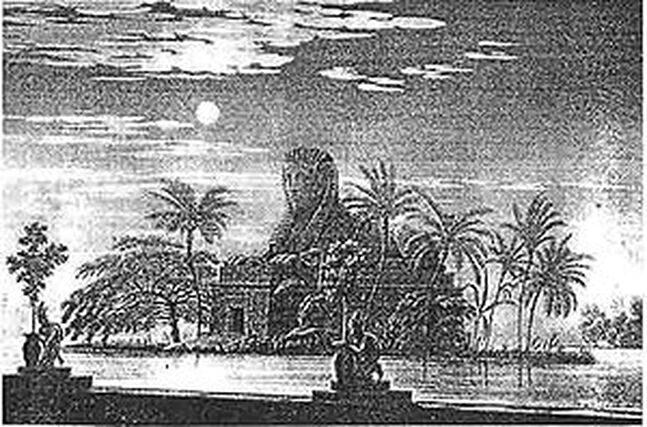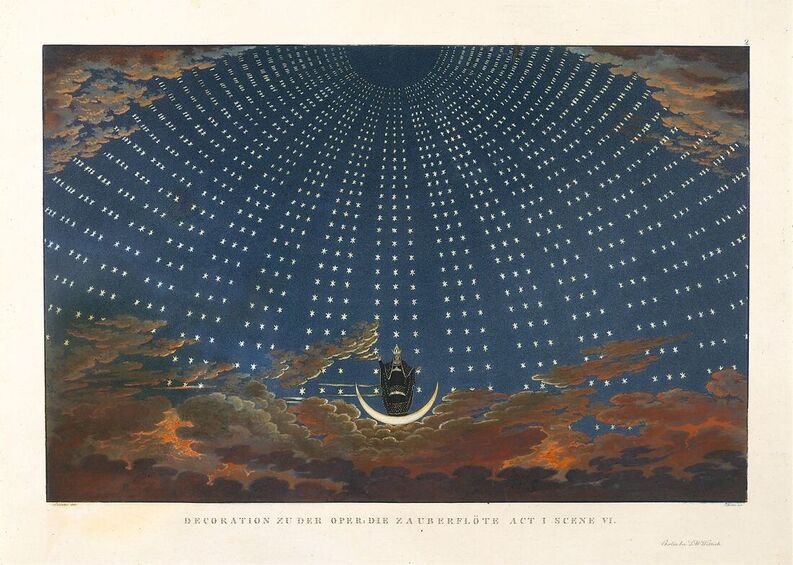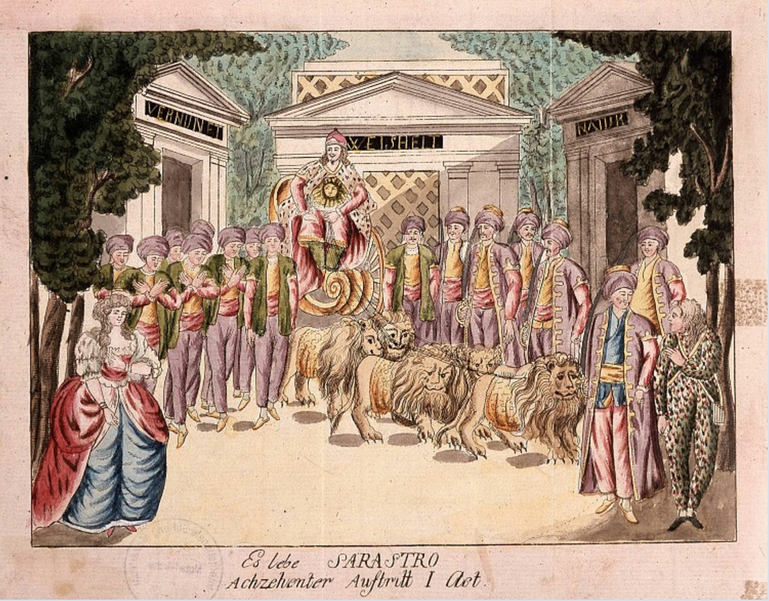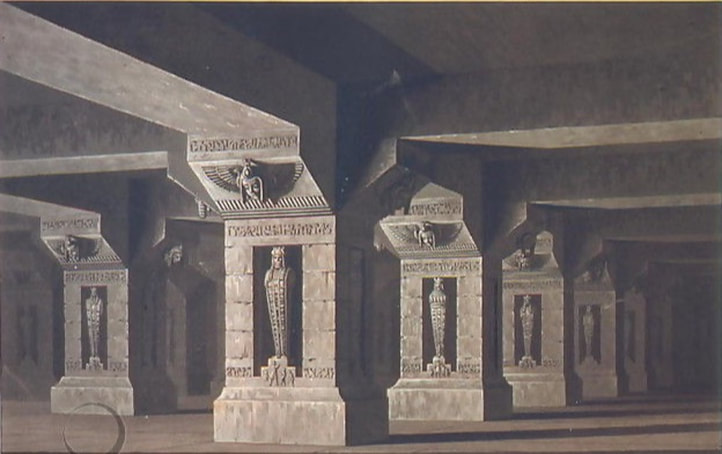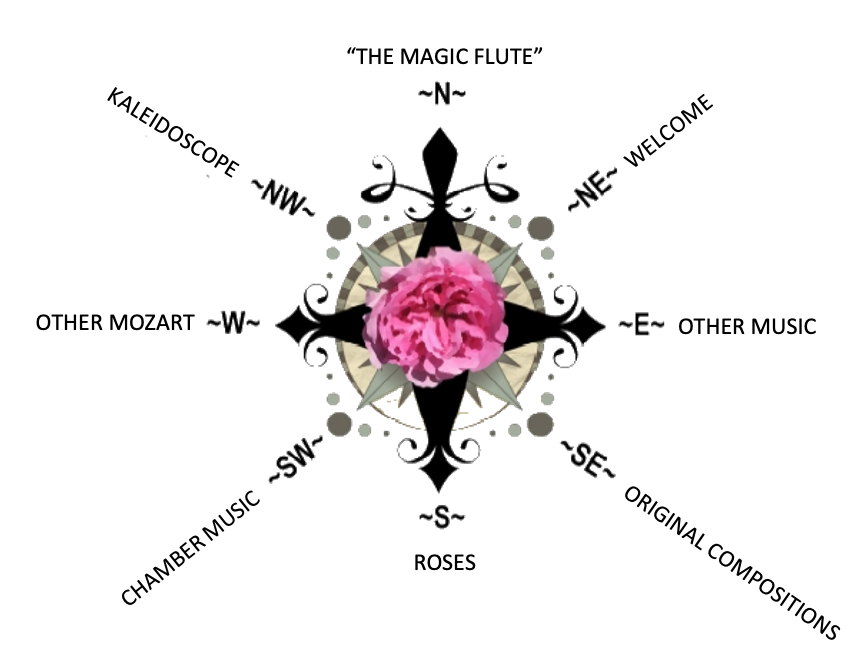- Home
- N - The Magic Flute
- NE - Welcome!
-
E - Other Music
- E - Music Genres >
- E - Composers >
-
E - Extended Discussions
>
- Allegri: Miserere
- Bach: Cantata 4
- Bach: Cantata 8
- Bach: Chaconne in D minor
- Bach: Concerto for Violin and Oboe
- Bach: Motet 6
- Bach: Passion According to St. John
- Bach: Prelude and Fugue in B-minor
- Bartok: String Quartets
- Brahms: A German Requiem
- David: The Desert
- Durufle: Requiem
- Faure: Cantique de Jean Racine
- Faure: Requiem
- Handel: Christmas Portion of Messiah
- Haydn: Farewell Symphony
- Liszt: Évocation à la Chapelle Sistine"
- Poulenc: Gloria
- Poulenc: Quatre Motets
- Villa-Lobos: Bachianas Brazilieras
- Weill
-
E - Grace Woods
>
- Grace Woods: 4-29-24
- Grace Woods: 2-19-24
- Grace Woods: 1-29-24
- Grace Woods: 1-8-24
- Grace Woods: 12-3-23
- Grace Woods: 11-20-23
- Grace Woods: 10-30-23
- Grace Woods: 10-9-23
- Grace Woods: 9-11-23
- Grace Woods: 8-28-23
- Grace Woods: 7-31-23
- Grace Woods: 6-5-23
- Grace Woods: 5-8-23
- Grace Woods: 4-17-23
- Grace Woods: 3-27-23
- Grace Woods: 1-16-23
- Grace Woods: 12-12-22
- Grace Woods: 11-21-2022
- Grace Woods: 10-31-2022
- Grace Woods: 10-2022
- Grace Woods: 8-29-22
- Grace Woods: 8-8-22
- Grace Woods: 9-6 & 9-9-21
- Grace Woods: 5-2022
- Grace Woods: 12-21
- Grace Woods: 6-2021
- Grace Woods: 5-2021
- E - Trinity Cathedral >
- SE - Original Compositions
- S - Roses
-
SW - Chamber Music
- 12/93 The Shostakovich Trio
- 10/93 London Baroque
- 3/93 Australian Chamber Orchestra
- 2/93 Arcadian Academy
- 1/93 Ilya Itin
- 10/92 The Cleveland Octet
- 4/92 Shura Cherkassky
- 3/92 The Castle Trio
- 2/92 Paris Winds
- 11/91 Trio Fontenay
- 2/91 Baird & DeSilva
- 4/90 The American Chamber Players
- 2/90 I Solisti Italiana
- 1/90 The Berlin Octet
- 3/89 Schotten-Collier Duo
- 1/89 The Colorado Quartet
- 10/88 Talich String Quartet
- 9/88 Oberlin Baroque Ensemble
- 5/88 The Images Trio
- 4/88 Gustav Leonhardt
- 2/88 Benedetto Lupo
- 9/87 The Mozartean Players
- 11/86 Philomel
- 4/86 The Berlin Piano Trio
- 2/86 Ivan Moravec
- 4/85 Zuzana Ruzickova
-
W - Other Mozart
- Mozart: 1777-1785
- Mozart: 235th Commemoration
- Mozart: Ave Verum Corpus
- Mozart: Church Sonatas
- Mozart: Clarinet Concerto
- Mozart: Don Giovanni
- Mozart: Exsultate, jubilate
- Mozart: Magnificat from Vesperae de Dominica
- Mozart: Mass in C, K.317 "Coronation"
- Mozart: Masonic Funeral Music,
- Mozart: Requiem
- Mozart: Requiem and Freemasonry
- Mozart: Sampling of Solo and Chamber Works from Youth to Full Maturity
- Mozart: Sinfonia Concertante in E-flat
- Mozart: String Quartet No. 19 in C major
- Mozart: Two Works of Mozart: Mass in C and Sinfonia Concertante
- NW - Kaleidoscope
- Contact
"THE MAGIC FLUTE" PLOT
by Judith Eckelmeyer
Opera is a blend of visual, aural, verbal, and kinetic aspects—all with symbolic potential. The Magic Flute is a variety of opera called German Singspiel, with spoken dialogue as well as sung pieces.
CHARACTERS IN "THE MAGIC FLUTE":
|
SARASTRO
(bass) |
TAMINO
(tenor) (magic flute) |
PAMINA
(lyric soprano) |
QUEEN OF NIGHT
(coloratura soprano) |
|
3 GENII (or BOYS)
(treble—children) |
PAPAGENO
(baritone) (pan pipes, magic bells) |
PAPAGENA
(soprano) |
3 LADIES
(2 sopranos, mezzo soprano) |
|
MONOSTATOS
(tenor) |
PRIESTS, SLAVES and GUARDS in SARASTRO’S REALM
(tenor, baritone, bass) |
CHORUS
(S.A.T.B) |
THE STORY
The plot of The Magic Flute is given here in stage sets, rather than in traditional scenes, so as to give a clearer picture of where the action is taking place for each event. However, there is great symbolic significance to the original scene numbering as found in the printed libretto of 1791. The original scene numbers are given in parentheses in this narration. (Curiously, in Act II scenes 30, 31, and 32 are not indicated in the original libretto.) Elsewhere on this website there are explanations of some of the numbers, which will help the reader identify how the opera’s creators took special pains to embed symbolic information into the work.
Scene descriptions are taken directly from the original libretto.
Scene descriptions are taken directly from the original libretto.
"The Magic Flute" - ACT I
Opening Stage Set: a rocky and wild-looking region; in the background is a round temple.
(1) TAMINO, a prince, is lost in a wild place. Threatened by a pursuing serpent, he faints. The temple door opens and THREE LADIES, veiled in black, emerge; they prod the serpent into three segments, saving Tamino’s life. We learn that they are servants of the QUEEN OF THE NIGHT, and they go off to inform her of the presence of the young man in her territory.
(2) PAPAGENO, a lonely birdcatcher, enters playing his primitive five-note pan-pipes; he finds the unconscious prince and, when Tamino revives, they exchange information. We learn that Papageno makes his living by providing birds to the Queen of the Night but he has never seen her. Tamino has heard of her from his father. He asks Papageno if he killed the serpent. Papageno claims to have strangled it.
(3) The Ladies enter, having overheard him, and punish him for lying by placing a padlock on his mouth, giving him a stone rather than bread to eat and water rather than wine to drink. They tell Tamino of their courageous victory over the serpent, and then give the prince a portrait of the Queen’s daughter, PAMINA. They explain that an evil spirit named SARASTRO has taken her away.
(4) Tamino looks at the portrait and falls in love with the image.
(5) The Three Ladies return, encouraged that Tamino is interested in the young woman in the portrait.
(6) Then the mountains part and Pamina’s mother, the QUEEN OF THE NIGHT, emerges from a rocky cavern lined with sparkling stars. Recognizing that Tamino has fallen in love with the portrait of her daughter, she hires Tamino to rescue her from Sarastro’s realm, after which they may marry.
(7) Once the Queen has disappeared, Papageno tries to have Tamino remove the padlock from his mouth, but Tamino isn’t able to do this.
(8) The Three Ladies return and remove Papageno’s padlock and warn him not to lie anymore. They give Tamino a magic flute that will protect him in danger. They tell Papageno that he is to accompany Tamino, and give him a set of magic bells, which will transform sadness to joy. They predict that THREE BOYS will guide the men while they are in Sarastro’s realm.
(1) TAMINO, a prince, is lost in a wild place. Threatened by a pursuing serpent, he faints. The temple door opens and THREE LADIES, veiled in black, emerge; they prod the serpent into three segments, saving Tamino’s life. We learn that they are servants of the QUEEN OF THE NIGHT, and they go off to inform her of the presence of the young man in her territory.
(2) PAPAGENO, a lonely birdcatcher, enters playing his primitive five-note pan-pipes; he finds the unconscious prince and, when Tamino revives, they exchange information. We learn that Papageno makes his living by providing birds to the Queen of the Night but he has never seen her. Tamino has heard of her from his father. He asks Papageno if he killed the serpent. Papageno claims to have strangled it.
(3) The Ladies enter, having overheard him, and punish him for lying by placing a padlock on his mouth, giving him a stone rather than bread to eat and water rather than wine to drink. They tell Tamino of their courageous victory over the serpent, and then give the prince a portrait of the Queen’s daughter, PAMINA. They explain that an evil spirit named SARASTRO has taken her away.
(4) Tamino looks at the portrait and falls in love with the image.
(5) The Three Ladies return, encouraged that Tamino is interested in the young woman in the portrait.
(6) Then the mountains part and Pamina’s mother, the QUEEN OF THE NIGHT, emerges from a rocky cavern lined with sparkling stars. Recognizing that Tamino has fallen in love with the portrait of her daughter, she hires Tamino to rescue her from Sarastro’s realm, after which they may marry.
(7) Once the Queen has disappeared, Papageno tries to have Tamino remove the padlock from his mouth, but Tamino isn’t able to do this.
(8) The Three Ladies return and remove Papageno’s padlock and warn him not to lie anymore. They give Tamino a magic flute that will protect him in danger. They tell Papageno that he is to accompany Tamino, and give him a set of magic bells, which will transform sadness to joy. They predict that THREE BOYS will guide the men while they are in Sarastro’s realm.
Second Stage Set: a splendid room with oriental furnishings and décor.
(9) THREE SLAVES gossip about Pamina’s recent escape from MONOSTATOS, a Moor charged with keeping watch over her. In disparaging tones they describe Monostatos as a “fat-belly” and hope that Pamina makes good her escape by gondola on the canal.
(10) They express dismay when they learn that Pamina is recaptured.
(11) Monostatos enters, pulling her into the room. He attempts to force her to submit to his attentions, but she vigorously resists him, then faints. Monostatos orders the slaves out of the room.
(12) Papageno bumbles his way into the room, and when he and Monostatos see each other, both assume they’ve seen the Devil. Monostatos runs away, but Papageno merely cowers in place.
(13) Pamina recovers from her faint to see the feathered Papageno and
(14) begins a conversation with him. Papageno has the portrait that had been given to Tamino and uses it to identify Pamina. As a result of Pamina’s questions about how he acquired the portrait, she learns that her mother gave it to Tamino, a prince, who loves her and is coming to rescue her. Papageno laments that no one loves him, and the two sing a duet about the joys of love before they run off to try to find Tamino.
Second Stage Set: a splendid room with oriental furnishings and décor.
(9) THREE SLAVES gossip about Pamina’s recent escape from MONOSTATOS, a Moor charged with keeping watch over her. In disparaging tones they describe Monostatos as a “fat-belly” and hope that Pamina makes good her escape by gondola on the canal.
(10) They express dismay when they learn that Pamina is recaptured.
(11) Monostatos enters, pulling her into the room. He attempts to force her to submit to his attentions, but she vigorously resists him, then faints. Monostatos orders the slaves out of the room.
(12) Papageno bumbles his way into the room, and when he and Monostatos see each other, both assume they’ve seen the Devil. Monostatos runs away, but Papageno merely cowers in place.
(13) Pamina recovers from her faint to see the feathered Papageno and
(14) begins a conversation with him. Papageno has the portrait that had been given to Tamino and uses it to identify Pamina. As a result of Pamina’s questions about how he acquired the portrait, she learns that her mother gave it to Tamino, a prince, who loves her and is coming to rescue her. Papageno laments that no one loves him, and the two sing a duet about the joys of love before they run off to try to find Tamino.
Third Stage Set: before three temples bearing the inscriptions “Nature”, “Reason”, “Wisdom”. The temples and the grounds around them are well kept.
(15) Tamino, separated from Pageno, is guided by the Three Boys, who advise him to be patient, steadfast, and silent if he wishes to conquer like a man. Tamino then tries to enter the Temple of Nature, but voices within tell him to stand back. He then tries the Temple of Reason, but again the voices refuse him entry. He approaches the Temple of Wisdom but is met by an old PRIEST, the Speaker, who asks what Tamino is looking for there. Tamino explains that he seeks the property of love and virtue, and that he is driven by a desire for vengeance on a villain. When the Priest explains that Sarastro is no villain and that Sarastro rules in the Temple of Wisdom, Tamino concludes that everything is hypocrisy and begins to leave the area. The Priest engages him further and learns that Pamina’s mother is the source of his information. He explains that indeed, Sarastro did take the Queen’s daughter from her. However, in order to understand why and to rescue Pamina, Tamino must subject himself to trials of his worthiness and join the brotherhood in the Temple of Wisdom. Hidden voices tell Tamino that Pamina is still alive, and in his joy Tamino plays his magic flute. Immediately, all kinds of birds and creatures come to hear the music, but Pamina does not appear. Tamino does hear Papageno’s panpipes, though, and he goes off to find the birdcatcher.
(16) Meanwhile, Papageno and Pamina make their way to the temple area where
(17) Monostatos catches up with them. He is about to have his Slaves chain them when Papageno is inspired to play his magic bells. Hearing the music, Monostatos and the Slaves become merry and dance away singing, leaving Papageno and Pamina to wonder at the power of the bells’ music.
(18) A fanfare announces Sarastro’s approach. He enters in a chariot drawn by six lions, accompanied by his entourage. Pamina relates how Monostatos intended to assault her, inducing her to flee. Sarastro expresses his understanding but refuses to return her to her mother, saying a man must guide her now. Meanwhile, Monostatos has captured Tamino and brings him to the temple area. Tamino and Pamina recognize each other and eagerly embrace, but an indignant Monostatos separates them, suggesting to Sarastro that his watchfulness has protected Pamina. Sarastro, now aware of Monostatos’s intent to attack Pamina, “rewards” him with a beating on the feet. Tamino and Papageno are blindfolded and sent off to go through ritual trials, and Monostatos is taken away for punishment.
"The Magic Flute" - ACT II
First Stage Set: a palm grove—the trees are silvery, the leaves gold. There are 18 seats of leaves. On each seat is a pyramid and a large black horn worked with gold. In the middle are the largest pyramid and the largest trees. Sarastro and other priests, each carrying a palm branch, enter ceremonially to a march with wind instruments.
(1) Sarastro explains to the Priests that their meeting is the most important of their time, for Tamino, a king’s son, 20 years old, is awaiting with a virtuous heart to achieve his goal—to tear away the dark veil and look into the sanctuary of the greatest light. Individual Priests ask if he is virtuous, able to keep silent, and benevolent. Sarastro vouches for his character, and the Priests blow their horns three times. Sarastro explains that when Tamino concludes his learning, prejudice will disappear. He will then win Pamina. It was for this reason that he took Pamina from her vain and deceptive mother. As an initiate, Tamino will buffer their temple. A priest asks if Tamino, a prince, can persevere in the face of the difficulties and pain that the trials will bring him. Sarastro responds that Tamino is more than royalty—he is a human being. And if he dies while undergoing the trials, he will be with the gods sooner than they will. The Priests blow their horns three times in accord. He then commends Tamino and Papageno to the care of the Speaker Priest who will oversee the training of the candidates in “the duty of humanity” and to know the power of the gods. Sarastro and the priests sing a prayer to Isis and Osiris, asking them to guide and strengthen the candidates.
(1) Sarastro explains to the Priests that their meeting is the most important of their time, for Tamino, a king’s son, 20 years old, is awaiting with a virtuous heart to achieve his goal—to tear away the dark veil and look into the sanctuary of the greatest light. Individual Priests ask if he is virtuous, able to keep silent, and benevolent. Sarastro vouches for his character, and the Priests blow their horns three times. Sarastro explains that when Tamino concludes his learning, prejudice will disappear. He will then win Pamina. It was for this reason that he took Pamina from her vain and deceptive mother. As an initiate, Tamino will buffer their temple. A priest asks if Tamino, a prince, can persevere in the face of the difficulties and pain that the trials will bring him. Sarastro responds that Tamino is more than royalty—he is a human being. And if he dies while undergoing the trials, he will be with the gods sooner than they will. The Priests blow their horns three times in accord. He then commends Tamino and Papageno to the care of the Speaker Priest who will oversee the training of the candidates in “the duty of humanity” and to know the power of the gods. Sarastro and the priests sing a prayer to Isis and Osiris, asking them to guide and strengthen the candidates.
Second Stage Set: night; thunder in the distance. A forecourt of the temple with ruins of fallen columns and pyramids, thorn bushes. On either side high doors fronting onto wings of the temple.
(2) The Speaker and another Priest lead Tamino and Papageno in and remove their blindfolds. Papageno confesses to being frightened, but Tamino urges him to be a man.
(3) The Speaker and Priest return with torches and ask if the two candidates are prepared to fight with their life for their goals. Tamino responds “Yes” confidently, even if it meant death. Papageno is very hesitant to agree to go forward with the trials, saying he’s really interested not in wisdom but things a natural person wants—food, drink, sleep, and perhaps a pretty little woman. The Priest states that the only way to find a woman is to go through the trials, and not fear death. When Papageno says he would rather stay single, the Priest suggests that there is a girl just like him, young and pretty. Papageno longs to see her “just out of curiosity”, but doesn’t want to die to do so. The Priest promises that he can see her, but he must not talk to her. Papageno glibly agrees. The Speaker and Priest warn the two candidates against the wiles of women, then take their torches and leave.
(4) Papageno realized they can’t see anything without the Priests there, and Tamino advises him to be patient.
(5) The Three Ladies enter and try to engage Tamino and Papageno in conversation. Papageno forgets the Priests’ warning and tries to chat, but Tamino rebuffs them and barely is able to keep Papageno quiet. Priests’ calls from within the temple frighten off the women amid thunder and lightning, and Papageno faints.
(6) The Speaker and Priest enter. The Speaker congratulates Tamino, blindfolds him, and leads him out to his next trial. The Priest has to bolster Papageno’s courage, blindfolds him, and leads him to the next trial.
Second Stage Set: night; thunder in the distance. A forecourt of the temple with ruins of fallen columns and pyramids, thorn bushes. On either side high doors fronting onto wings of the temple.
(2) The Speaker and another Priest lead Tamino and Papageno in and remove their blindfolds. Papageno confesses to being frightened, but Tamino urges him to be a man.
(3) The Speaker and Priest return with torches and ask if the two candidates are prepared to fight with their life for their goals. Tamino responds “Yes” confidently, even if it meant death. Papageno is very hesitant to agree to go forward with the trials, saying he’s really interested not in wisdom but things a natural person wants—food, drink, sleep, and perhaps a pretty little woman. The Priest states that the only way to find a woman is to go through the trials, and not fear death. When Papageno says he would rather stay single, the Priest suggests that there is a girl just like him, young and pretty. Papageno longs to see her “just out of curiosity”, but doesn’t want to die to do so. The Priest promises that he can see her, but he must not talk to her. Papageno glibly agrees. The Speaker and Priest warn the two candidates against the wiles of women, then take their torches and leave.
(4) Papageno realized they can’t see anything without the Priests there, and Tamino advises him to be patient.
(5) The Three Ladies enter and try to engage Tamino and Papageno in conversation. Papageno forgets the Priests’ warning and tries to chat, but Tamino rebuffs them and barely is able to keep Papageno quiet. Priests’ calls from within the temple frighten off the women amid thunder and lightning, and Papageno faints.
(6) The Speaker and Priest enter. The Speaker congratulates Tamino, blindfolds him, and leads him out to his next trial. The Priest has to bolster Papageno’s courage, blindfolds him, and leads him to the next trial.
Third Stage Set: night, a garden, with trees forming a horseshoe. In the middle is an arbor of flowers and roses, in which Pamina is asleep. The light of the moon shines on Pamina’s face.
(7) Monostatos finds Pamina asleep and ruminates on the pain he has just suffered in punishment because of her. Reflecting that he is like any other man, and is overwhelmed by desire for her, he determines to steal a kiss. Just as he is about to kiss Pamina,
(8) the Queen appears and orders him back. Pamina awakes and realizes her mother is standing there. Monostatos thus learns that Pamina is the Queen’s daughter and decides to watch how this encounter turns out. The Queen asks Pamina where the prince is whom she sent to rescue her. Pamina explains that he is dedicated to the Temple Initiates; since her father was one of them, she asks how the Queen can be angry with her for loving Tamino. The Queen reveals that Pamina is now out of her protection. When Pamina’s father died he gave the “seven-fold sun-circle” to the Initiates, and Sarastro now wears it. The Queen believes it is rightly hers. Seething with anger, she gives Pamina a knife and orders Pamina to kill Sarastro and bring her the sun-circle, or she will abandon and disown her forever. As the Queen disappears,
(9) Pamina determines that she cannot commit murder.
(10) Monostatos, who has overheard all of the conversation, tries to convince her that her mother is now in his power and will die if Pamina does not agree to succumb to his advances. Pamina tells him that she has dedicated her heart to Tamino and steadfastly refuses Monostatos, even though he now has the knife and threatens her life.
(11) He is about to kill Pamina when Sarastro intervenes, taking the knife from him and giving it back to Pamina. He says that he knows all about Monostatos’s evil deed, and banishes him from the realm of the Initiates. Monostatos decides to go to join the Queen.
(12) Pamina intercedes for her mother. Sarastro comforts Pamina and explains the ethos of his community: forgiveness rather than vengeance, and loving assistance to return the fallen to their duty.
Third Stage Set: night, a garden, with trees forming a horseshoe. In the middle is an arbor of flowers and roses, in which Pamina is asleep. The light of the moon shines on Pamina’s face.
(7) Monostatos finds Pamina asleep and ruminates on the pain he has just suffered in punishment because of her. Reflecting that he is like any other man, and is overwhelmed by desire for her, he determines to steal a kiss. Just as he is about to kiss Pamina,
(8) the Queen appears and orders him back. Pamina awakes and realizes her mother is standing there. Monostatos thus learns that Pamina is the Queen’s daughter and decides to watch how this encounter turns out. The Queen asks Pamina where the prince is whom she sent to rescue her. Pamina explains that he is dedicated to the Temple Initiates; since her father was one of them, she asks how the Queen can be angry with her for loving Tamino. The Queen reveals that Pamina is now out of her protection. When Pamina’s father died he gave the “seven-fold sun-circle” to the Initiates, and Sarastro now wears it. The Queen believes it is rightly hers. Seething with anger, she gives Pamina a knife and orders Pamina to kill Sarastro and bring her the sun-circle, or she will abandon and disown her forever. As the Queen disappears,
(9) Pamina determines that she cannot commit murder.
(10) Monostatos, who has overheard all of the conversation, tries to convince her that her mother is now in his power and will die if Pamina does not agree to succumb to his advances. Pamina tells him that she has dedicated her heart to Tamino and steadfastly refuses Monostatos, even though he now has the knife and threatens her life.
(11) He is about to kill Pamina when Sarastro intervenes, taking the knife from him and giving it back to Pamina. He says that he knows all about Monostatos’s evil deed, and banishes him from the realm of the Initiates. Monostatos decides to go to join the Queen.
(12) Pamina intercedes for her mother. Sarastro comforts Pamina and explains the ethos of his community: forgiveness rather than vengeance, and loving assistance to return the fallen to their duty.
Fourth Stage Set: a hall with a grassy bank.
(13) The Speaker and Priest lead in Tamino and Papageno and warn them to keep silent and follow the sound of trumpets. The two guides leave, and Papageno immediately tries to engage Tamino in conversation. When Tamino doesn’t respond,
(14) Papageno complains to himself that he doesn’t even have any water.
(15) An ugly OLD WOMAN with a beaker of water emerges from the ground and offers Papageno a drink. He begins to talk with her and learns she is 18 years and 2 minutes old, and her boyfriend’s name is Papageno. He grabs the water and sprinkles her with it, and asks her name. Before she can utter it, loud thunder interrupts and she limps away. He vows he won’t say another word, and Tamino gestures to him threateningly.
(16) The Three Boys enter in a flying machine decorated with roses; they have with them a table with food and also bring Tamino’s flute and Papageno’s bells. They tell the men that they may eat, and enourage them to be courageous and silent. The Boys leave.
(17) Papageno begins to eat, but Tamino briefly plays his flute.
(18) Pamina enters and tries to converse with Tamino, but he merely sighs and waves her away. She construes this to mean that he no longer loves her, and, weeping, decides to seek peace in death. She leaves, and
(19) trombones sound signaling Tamino to depart. Tamino tries to lead Papageno out with him, but Papageno resists, saying even Sarastro’s lions wouldn’t make him budge. Suddenly the lions appear, and Papageno calls out for Tamino’s help. Tamino plays his flute and the lions leave. As trombones continue to sound, Tamino finally is able to drag Papageno off to the next test.
Fourth Stage Set: a hall with a grassy bank.
(13) The Speaker and Priest lead in Tamino and Papageno and warn them to keep silent and follow the sound of trumpets. The two guides leave, and Papageno immediately tries to engage Tamino in conversation. When Tamino doesn’t respond,
(14) Papageno complains to himself that he doesn’t even have any water.
(15) An ugly OLD WOMAN with a beaker of water emerges from the ground and offers Papageno a drink. He begins to talk with her and learns she is 18 years and 2 minutes old, and her boyfriend’s name is Papageno. He grabs the water and sprinkles her with it, and asks her name. Before she can utter it, loud thunder interrupts and she limps away. He vows he won’t say another word, and Tamino gestures to him threateningly.
(16) The Three Boys enter in a flying machine decorated with roses; they have with them a table with food and also bring Tamino’s flute and Papageno’s bells. They tell the men that they may eat, and enourage them to be courageous and silent. The Boys leave.
(17) Papageno begins to eat, but Tamino briefly plays his flute.
(18) Pamina enters and tries to converse with Tamino, but he merely sighs and waves her away. She construes this to mean that he no longer loves her, and, weeping, decides to seek peace in death. She leaves, and
(19) trombones sound signaling Tamino to depart. Tamino tries to lead Papageno out with him, but Papageno resists, saying even Sarastro’s lions wouldn’t make him budge. Suddenly the lions appear, and Papageno calls out for Tamino’s help. Tamino plays his flute and the lions leave. As trombones continue to sound, Tamino finally is able to drag Papageno off to the next test.
Fifth Stage Set: the vaults of the pyramids. Two priests carry an illuminated pyramid on their shoulders; other priests each carry in their hands a transparent pyramid like a lantern.
(20) The priests celebrate the progress of the prince and predict the sun will banish the night.
(21) Tamino is led in and told he has two dangerous tests to endure. Pamina is then brought in, and Sarastro tells the pair that this is their last farewell. They all leave.
(22) Papageno finds his way into the vault, lost and frightened, seeking Tamino.
(23) The Speaker enters to tell him that the gods have decreed that in spite of his failures he will not have to wander in darkness for the rest of his life—but will not experience the status of Initiate. Papageno accepts this and says his only desire is a glass of wine. The Speaker grants this, and a glass of wine appears from the earth. As Papageno begins to drink he is aware of his heart’s desire: a girlfriend or wife. As he sings and plays his bells,
(24) the Old Woman dances in, supporting herself with her cane, and offers herself as a mate for Papageno. At first he refuses to consider her offer, but when faced with a life with no companion and only bread and water for food, he relents. The Old Woman extracts his vow of fidelity (although he whispers to himself an escape clause), and immediately she transforms into a young woman clothed like him. He tries to embrace her, but
(25) the Speaker separates them, telling Papagena that Papageno is not yet worthy of her. Papageno boasts that the earth will have to swallow him before he lets the young woman get away, but the ground recedes beneath him and he falls down in fear.
Fifth Stage Set: the vaults of the pyramids. Two priests carry an illuminated pyramid on their shoulders; other priests each carry in their hands a transparent pyramid like a lantern.
(20) The priests celebrate the progress of the prince and predict the sun will banish the night.
(21) Tamino is led in and told he has two dangerous tests to endure. Pamina is then brought in, and Sarastro tells the pair that this is their last farewell. They all leave.
(22) Papageno finds his way into the vault, lost and frightened, seeking Tamino.
(23) The Speaker enters to tell him that the gods have decreed that in spite of his failures he will not have to wander in darkness for the rest of his life—but will not experience the status of Initiate. Papageno accepts this and says his only desire is a glass of wine. The Speaker grants this, and a glass of wine appears from the earth. As Papageno begins to drink he is aware of his heart’s desire: a girlfriend or wife. As he sings and plays his bells,
(24) the Old Woman dances in, supporting herself with her cane, and offers herself as a mate for Papageno. At first he refuses to consider her offer, but when faced with a life with no companion and only bread and water for food, he relents. The Old Woman extracts his vow of fidelity (although he whispers to himself an escape clause), and immediately she transforms into a young woman clothed like him. He tries to embrace her, but
(25) the Speaker separates them, telling Papagena that Papageno is not yet worthy of her. Papageno boasts that the earth will have to swallow him before he lets the young woman get away, but the ground recedes beneath him and he falls down in fear.
Sixth Stage Set: a small garden.
(26) The Three Boys descend in their flying chariot and predict the approach of morning, the disappearance of delusion and the victory of the wise one. They pray that calm will return to humankind so that earth will be a heavenly kingdom and mortals like gods.
(27) The Boys spy Pamina coming and realize she is in great despair, even about to kill herself. Her grief is evident in her speech. The Boys, seeing that she is beside herself, intervene as she is about to kill herself with her mother’s dagger. They convince her that Tamino indeed loves her and is acting as he does from love of her. She and the Boys hurry off to find him.
Sixth Stage Set: a small garden.
(26) The Three Boys descend in their flying chariot and predict the approach of morning, the disappearance of delusion and the victory of the wise one. They pray that calm will return to humankind so that earth will be a heavenly kingdom and mortals like gods.
(27) The Boys spy Pamina coming and realize she is in great despair, even about to kill herself. Her grief is evident in her speech. The Boys, seeing that she is beside herself, intervene as she is about to kill herself with her mother’s dagger. They convince her that Tamino indeed loves her and is acting as he does from love of her. She and the Boys hurry off to find him.
Seventh Stage Set: two large mountains in the background, one with a waterfall, the other spewing fire. In front of each of them is a fence through which one can see the fire and water; black fog hovers over the waterfall, and over the fire the horizon is bright red. In the middle, at the top, is a pyramid on which there is transparent writing. An iron gate is in the front and rocks lie at the sides.
(28) Tamino enters; he is lightly clothed and without sandals. Leading him are two men in black armor; fire burns on their helmets. They read to Tamino the script on the pyramid: “He who travels this road full of hardship becomes pure through fire, water, air, and earth. If he can overcome the fear of death, he rises heavenward from earth. Enlightened, he will then be able to devote himself completely to the mysteries of Isis and Osiris.” Tamino responds that death holds no fear for him as he walks the path of virtue.
Suddenly, Pamina calls out, and the two Armored Men say that they may speak with each other, and that she is worthy to join Tamino on the two great trials of fire and water. She joins Tamino and explains the origin of the magic flute which he now has: her father carved it during a thunderstorm from a thousand-year-old oak. Now when he plays it, it will protect them in the coming dangerous trials. Together they enter first the fire, then the water, all the while Tamino playing the flute. As they emerge from the water, a door opens, and one sees an entrance into a temple which is brightly lighted. There is a ceremonial silence. A hidden chorus, with trumpets and drums, celebrates the victory of the noble couple.
Seventh Stage Set: two large mountains in the background, one with a waterfall, the other spewing fire. In front of each of them is a fence through which one can see the fire and water; black fog hovers over the waterfall, and over the fire the horizon is bright red. In the middle, at the top, is a pyramid on which there is transparent writing. An iron gate is in the front and rocks lie at the sides.
(28) Tamino enters; he is lightly clothed and without sandals. Leading him are two men in black armor; fire burns on their helmets. They read to Tamino the script on the pyramid: “He who travels this road full of hardship becomes pure through fire, water, air, and earth. If he can overcome the fear of death, he rises heavenward from earth. Enlightened, he will then be able to devote himself completely to the mysteries of Isis and Osiris.” Tamino responds that death holds no fear for him as he walks the path of virtue.
Suddenly, Pamina calls out, and the two Armored Men say that they may speak with each other, and that she is worthy to join Tamino on the two great trials of fire and water. She joins Tamino and explains the origin of the magic flute which he now has: her father carved it during a thunderstorm from a thousand-year-old oak. Now when he plays it, it will protect them in the coming dangerous trials. Together they enter first the fire, then the water, all the while Tamino playing the flute. As they emerge from the water, a door opens, and one sees an entrance into a temple which is brightly lighted. There is a ceremonial silence. A hidden chorus, with trumpets and drums, celebrates the victory of the noble couple.
Eighth Stage Set: the previous garden.
(29) Papageno is frustrated at losing his girlfriend and calls out for her in vain, even signaling for her with his panpipes. He finally decides he can’t stand living in this world and is about to hang himself from a tree when the Three Boys stop him. They suggest he try his magic bells. When he plays them Papagena appears, and the two begin to plan their family.
Eighth Stage Set: the previous garden.
(29) Papageno is frustrated at losing his girlfriend and calls out for her in vain, even signaling for her with his panpipes. He finally decides he can’t stand living in this world and is about to hang himself from a tree when the Three Boys stop him. They suggest he try his magic bells. When he plays them Papagena appears, and the two begin to plan their family.
Ninth Stage Set: the Temple of Wisdom.
(33) The Queen, Three Ladies, and Monostatos are under the temple, plotting to enter it and overcome Sarastro and the Initiates. When that happens, Monostatos will claim Pamina as his prize, and the Queen assents to this. But a great thunder and lightning storm happens, and the five sink out of sight.
The entire stage becomes a sun. Sarastro is elevated; Tamino and Pamina are both in priestly clothes. Next to them stand the Egyptian Priests, and the Three Boys hold flowers. Sarastro declares the night is gone and the power of the hypocrites annihilated. The chorus celebrates the success of the new Initiates and thanks Isis and Osiris. They conclude: “Strength was victorious, and, in reward, exalts beauty and wisdom with an eternal crown.”
Ninth Stage Set: the Temple of Wisdom.
(33) The Queen, Three Ladies, and Monostatos are under the temple, plotting to enter it and overcome Sarastro and the Initiates. When that happens, Monostatos will claim Pamina as his prize, and the Queen assents to this. But a great thunder and lightning storm happens, and the five sink out of sight.
The entire stage becomes a sun. Sarastro is elevated; Tamino and Pamina are both in priestly clothes. Next to them stand the Egyptian Priests, and the Three Boys hold flowers. Sarastro declares the night is gone and the power of the hypocrites annihilated. The chorus celebrates the success of the new Initiates and thanks Isis and Osiris. They conclude: “Strength was victorious, and, in reward, exalts beauty and wisdom with an eternal crown.”
Judith Eckelmeyer ©2015
Choose Your Direction
The Magic Flute, II,28.
